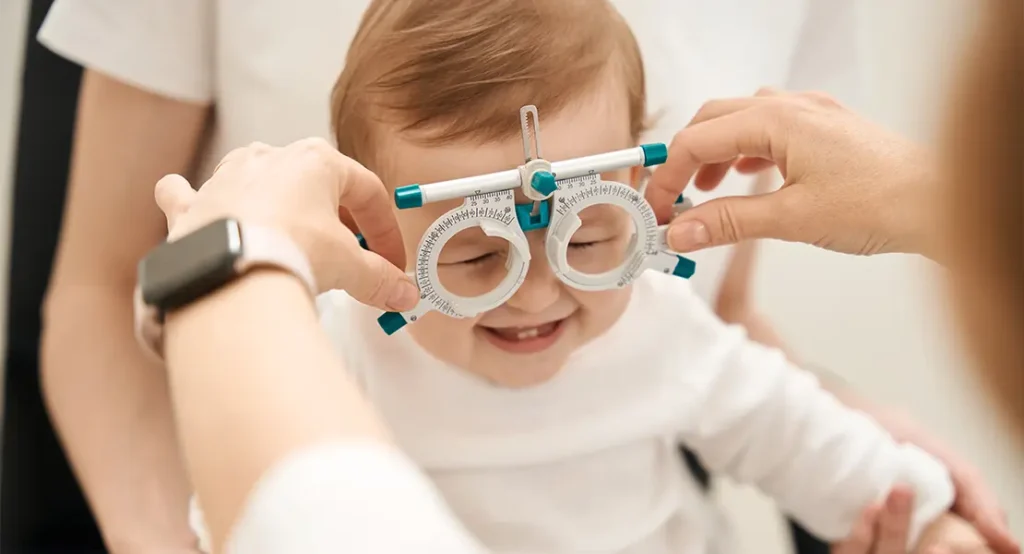Crystallin Protein Mutations
Crystallins are the most abundant structural proteins in the lens, playing a key role in maintaining its transparency and refractive properties. They are remarkably long-lived and highly stable under normal conditions. However, when mutations occur in crystallin-encoding genes such as CRYAA, CRYBB2, or CRYGC, the resulting proteins may misfold or become unstable. These abnormal proteins tend to clump together, forming aggregates that scatter light and reduce lens clarity.
Such aggregation disrupts the highly ordered arrangement of lens fibres, which is essential for allowing light to pass through unobstructed. Over time, these structural changes manifest as visible opacities—cataracts—which may be present at birth or develop in early childhood. The severity and speed of progression can vary depending on the specific mutation and its impact on protein behaviour. Some mutations produce only mild structural changes, while others can lead to dense, bilateral cataracts that severely impair vision.
Crystallin gene mutations typically follow a familial pattern, often inherited in an autosomal dominant manner. This means a single defective copy of the gene from one parent can be sufficient to cause disease. In affected families, cataracts may appear in multiple generations, sometimes with varying degrees of severity. Understanding the particular mutation involved can assist with genetic counselling and help anticipate the likelihood of recurrence in future offspring.
Disruption in Lens Membrane Proteins
The lens is a highly organised, avascular tissue that relies on efficient internal communication and water regulation to stay clear. This delicate balance is maintained in part by specialised membrane proteins, such as aquaporin 0 (encoded by MIP) and connexin 50 (encoded by GJA8). These proteins facilitate water movement and intercellular signalling between lens fibre cells, processes that are vital for maintaining lens homeostasis and transparency.
Mutations in the MIP gene can alter the function or placement of aquaporin channels, leading to abnormal water retention or dehydration within the lens. This results in cellular stress and swelling, both of which can disturb the internal architecture of the lens. Over time, the lens becomes increasingly clouded due to the disruption in its tightly packed cellular arrangement. These changes may begin in utero or shortly after birth, depending on the severity of the mutation.
Similarly, mutations in GJA8 impair the function of gap junction channels, which allow nutrients and ions to pass between lens cells. Without these essential exchanges, lens fibres cannot maintain their metabolic balance, leading to degeneration and opacification. In both cases, the disruption of lens membrane proteins can have profound effects early in life, underscoring their importance in paediatric cataract pathology. These mutations may occur spontaneously or be inherited, often following a dominant pattern.
Modes of Inheritance
The inheritance pattern of congenital cataracts can offer important clues about the underlying genetic cause. In many families, cataracts are passed on in an autosomal dominant manner, meaning a parent with the condition has a 50% chance of passing the mutation on to their children. These cases are often easier to trace through family history, and the clinical presentation tends to be relatively consistent across generations.
However, not all congenital cataracts follow this straightforward inheritance. Autosomal recessive cataracts occur when both parents are carriers of a faulty gene but do not themselves have the condition. In such cases, there is a 25% chance with each pregnancy that the child will inherit two defective copies and develop cataracts. These forms are often more severe and may be associated with additional developmental issues, depending on the gene involved.

X-linked cataracts are another, less common, inheritance pattern. These usually affect males more severely, as they inherit a single X chromosome from their mother. Females may carry the mutation but remain unaffected or show only mild symptoms due to the presence of a second, normal X chromosome. Identifying the mode of inheritance is essential not only for confirming a diagnosis but also for guiding family planning and assessing risk for future generations.
Syndromic Associations
In some instances, congenital cataracts are not isolated findings but part of a broader genetic syndrome that affects multiple organs or systems. One well-known example is Down syndrome, caused by trisomy 21, where cataracts may present alongside intellectual disability, cardiac defects, and characteristic facial features. In these cases, cataracts are one of several clinical clues that point towards a more complex diagnosis.
Another example is Lowe syndrome, an X-linked disorder characterised by a combination of eye, brain, and kidney abnormalities. Children with Lowe syndrome are often born with dense cataracts and may also exhibit developmental delays and metabolic abnormalities. Early identification of cataracts in these cases can prompt further testing, enabling more comprehensive care and early interventions that improve overall outcomes.
Recognising the syndromic context of congenital cataracts is crucial for accurate diagnosis and management. It allows healthcare providers to screen for associated health issues and ensure that the child receives the appropriate multidisciplinary support. Genetic testing can confirm the presence of syndromic conditions, while counselling can help families understand the broader implications for the child’s health and future wellbeing.
Hereditary Influences in Age-Related Cataracts
Genetic Predisposition Revealed Through Twin Studies
Twin studies have played a pivotal role in uncovering the genetic basis of age-related cataracts. By comparing rates of cataract development in monozygotic (identical) and dizygotic (fraternal) twins, researchers can determine how much of the risk is inherited. Identical twins share virtually all their genes, while fraternal twins share about half, similar to any siblings. If a trait like cataract formation is significantly more common in identical twins than in fraternal ones, it strongly suggests a genetic influence.
Findings from these studies have consistently shown that identical twins are more likely to develop the same type of cataract, at a similar age, than their fraternal counterparts. This is particularly true for nuclear and cortical cataracts, which affect the central and outer regions of the lens, respectively. Such strong concordance cannot be explained by shared environment alone, pointing to the role of heritable traits in determining lens health and vulnerability to ageing processes.
While these studies don’t identify the specific genes involved, they offer a compelling foundation for deeper genetic research. By establishing that cataracts have a heritable component, twin research paves the way for molecular studies that can isolate the actual genetic variants at play. Moreover, this line of research highlights the importance of early eye assessments for individuals with a family history of cataracts, as they may be genetically predisposed even before lifestyle or environmental risks come into effect.
Key Gene Variants Identified by GWAS
Genome-wide association studies (GWAS) have significantly advanced our understanding of the genetic architecture behind age-related cataracts. By analysing the DNA of large populations, GWAS can identify common genetic variants—known as single nucleotide polymorphisms (SNPs)—that appear more frequently in individuals with cataracts compared to those without. These studies have helped pinpoint genes involved in lens maintenance, cellular resilience, and metabolic balance.

Among the most notable discoveries is the association between the EPHA2 gene and cortical cataracts. This gene encodes a protein that plays a role in cell signalling and maintaining lens structure. Disruptions in EPHA2 may compromise the stability and longevity of lens cells, making them more susceptible to age-related damage. Individuals carrying certain variants of this gene may therefore be more prone to developing opacities in the outer layer of the lens as they grow older.
Other implicated genes are involved in oxidative stress regulation, a key factor in lens ageing. For example, genetic variants affecting antioxidant pathways can reduce the lens’s ability to neutralise free radicals, leading to cellular damage and protein denaturation. Similarly, defects in DNA repair genes may impair the lens’s response to UV-induced damage. GWAS findings are not only enriching our understanding of cataract biology but also identifying potential targets for preventive therapies and personalised interventions in the future.
Genetic Variations Influencing Progression and Cataract Type
Not all genetic variants directly cause cataracts, but many play a role in influencing how quickly they develop or which type emerges. These variations can subtly affect the biological processes that keep the lens clear, such as protein turnover, antioxidant defence, and metabolic homeostasis. Even small changes in these systems can shift the balance over time, particularly when combined with external stressors like sun exposure or smoking.
For instance, individuals who inherit certain gene variants may produce less efficient forms of protective enzymes. These enzymes normally help neutralise reactive oxygen species, which accumulate in the lens over time. If their activity is reduced due to genetic differences, the lens may experience accelerated damage, leading to an earlier onset of cloudiness. In such cases, the genetic factor doesn’t act alone but significantly lowers the threshold for environmental factors to exert their harmful effects.
Moreover, genetic differences can also shape the type of cataract that forms. While some individuals may be predisposed to nuclear sclerosis, others may develop cortical or posterior subcapsular opacities depending on the interplay between their genetic blueprint and lifestyle exposures. This individual variability highlights why cataract development is not uniform across populations and why personalised risk assessments—factoring in both genetics and environment—could become a cornerstone of future eye care strategies.
Inherited Metabolic Disorders and Cataract Formation
Several inherited metabolic conditions are known to lead to cataract formation, often through the accumulation of abnormal substances within the lens. These disruptions in metabolic pathways can result in biochemical imbalances that damage lens clarity over time.
Galactosaemia and galactitol accumulation
Galactosaemia is a genetic disorder caused by mutations that affect the body’s ability to break down galactose, a sugar found in milk and other dairy products. In individuals with this condition, galactose is converted into galactitol, a sugar alcohol that the body cannot efficiently remove. Galactitol builds up in the tissues, especially in the lens of the eye, drawing in water due to its osmotic properties. This causes the lens fibres to swell and lose their transparency, leading to cataract formation—often within the first weeks of life.
If untreated, galactosaemia not only causes visual impairment but can also result in liver dysfunction, developmental delay, and even fatal complications. Fortunately, early dietary intervention—typically involving the elimination of galactose from the diet—can prevent many of the systemic effects and reduce the risk of lens damage. However, in many cases, some degree of cataract formation may still occur before diagnosis, making early screening and newborn metabolic testing vital for preventing irreversible visual loss.

Other metabolic disorders linked to cataracts
In addition to galactosaemia, other inherited metabolic diseases can present with cataracts as part of a wider clinical picture. Homocystinuria, for example, results from a defect in methionine metabolism, leading to high levels of homocysteine in the blood. This accumulation affects the structural proteins of the lens and weakens the supporting zonular fibres, increasing the likelihood of lens dislocation and opacification. Patients may also experience skeletal abnormalities and cardiovascular complications, making comprehensive care essential.
Fabry disease and cerebrotendinous xanthomatosis are also known to affect the eyes through the accumulation of lipids or cholesterol derivatives. In Fabry disease, distinctive cataracts with a spoke-like appearance can form due to the build-up of globotriaosylceramide in the lens. These visual changes can serve as early clinical clues, especially in young males. Recognising these ocular signs allows for earlier diagnosis of systemic disorders, which can be treated with enzyme replacement therapy or other targeted interventions to slow disease progression.
Importance of early diagnosis and genetic screening
When a child presents with cataracts—particularly if they are bilateral or appear without a known cause—clinicians should consider an underlying metabolic or syndromic condition. Genetic screening offers a powerful tool to confirm a diagnosis, especially when combined with biochemical tests. Identifying the causative mutation enables more accurate treatment planning and opens the door to screening siblings or future pregnancies for the same condition. This is particularly important for autosomal recessive disorders, where both parents may unknowingly be carriers.
Beyond confirming a diagnosis, genetic screening has significant implications for the child’s overall health and long-term prognosis. By pinpointing a systemic condition early, clinicians can initiate appropriate medical or dietary treatments to address underlying issues before complications arise. In some cases, addressing the root cause may halt the progression of the cataracts themselves or at least prevent further damage. For families, a confirmed diagnosis also brings clarity and empowers them to make informed decisions about future healthcare planning.
Implications for Diagnosis, Treatment, and Research
Understanding the genetic mechanisms behind cataracts is not only relevant for rare metabolic disorders but also has broad implications for clinical practice and scientific innovation.
Genetic testing in paediatric cataracts
In paediatric ophthalmology, unexplained lens opacities often prompt a wider investigation into potential genetic or systemic causes. Genetic testing has become an essential component of this process, especially for infants and young children who cannot easily describe their symptoms. With advances in next-generation sequencing, clinicians can now identify mutations across a wide panel of genes associated with cataracts and related disorders. This allows for early diagnosis, targeted interventions, and better-informed decisions about the child’s care pathway.
For families, the results of genetic testing can be both reassuring and actionable. Knowing whether a cataract is part of a hereditary condition helps parents understand recurrence risks and whether other family members should be tested. It also guides ophthalmologists in determining whether the child requires only ocular treatment or broader multidisciplinary care. In some cases, a seemingly isolated cataract may be the first sign of a more serious genetic syndrome, and early genetic insight allows for swift referral to specialists for further evaluation.

Potential for gene-targeted therapies
Gene-targeted therapies are emerging as a promising frontier in the management of inherited eye conditions, including cataracts. With tools like CRISPR-Cas9, scientists are exploring the possibility of correcting specific mutations at the DNA level before they lead to lens damage. Although this technology is still largely experimental in the context of cataracts, it holds long-term potential for treating genetic conditions at their source, rather than simply managing the symptoms once they appear.
In addition to gene editing, pharmacological research is also advancing, with some studies investigating compounds that could stabilise lens proteins or reduce oxidative stress in genetically susceptible individuals. These approaches aim to delay the onset or slow the progression of cataracts, particularly in those known to carry high-risk gene variants. As more genetic pathways involved in lens maintenance are uncovered, the development of such precision treatments is likely to accelerate.
Research and the future of personalised ophthalmology
The rapid expansion of our understanding of cataract-related genes is shaping the future of personalised medicine in ophthalmology. Researchers are now able to map how specific genetic mutations affect the biochemical and structural integrity of the lens, offering insights into why certain individuals develop cataracts earlier or more aggressively than others. This knowledge is laying the groundwork for more nuanced diagnostic tools and treatment options tailored to each patient’s genetic profile.
As genetic testing becomes more affordable and accessible, routine screening may one day become part of preventative eye care, especially for those with a strong family history of lens disorders. This shift toward personalised ophthalmology promises to transform how we predict, detect, and manage cataracts. By combining genetic insights with clinical expertise, healthcare providers will be better equipped to offer proactive care, prevent vision loss, and improve outcomes for patients across all age groups.
Final Thoughts
While cataracts are often viewed through the lens of ageing and environmental exposure, genetics undeniably plays a critical and multifaceted role. From rare congenital mutations to common age-related gene variants, the genetic underpinnings of cataract formation are becoming increasingly evident. As our understanding deepens, we are likely to see a shift towards more precise, preventive, and personalised approaches to cataract care.
For patients and clinicians alike, this evolving knowledge presents new opportunities. Early genetic screening and family history assessments can guide timely interventions, while ongoing research offers the prospect of innovative treatments. Ultimately, embracing the genetic dimension of cataracts not only enhances patient care but also paves the way for broader insights into ocular health and ageing.

